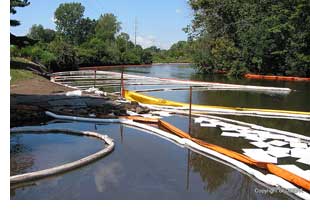Oil Spill Response:

Oil
spills are common events, happening on land and water, at any time of the day and in any weather condition. When oil is spilled/released
in the environment it can endanger public health, imperil drinking water, devastate natural resources, and disrupt the economy.
Preventing oil spills is the best strategy for avoiding potential damage to human health and the environment, therefore,
Oil Spill Prevention Planning is a critical part of ensuring quick and
organized response measures.
Containment and cleanup are your goal in a spill, however,
the primary consideration is human safety. Emergency responders must
understand the fundamental differences between safety considerations for petroleum product responses and those for other hazardous
materials incidents.
See
Hazardous Waste and Emergency Response Training Requirements
In the event of an oil spill:
Notify primary response agencies and affected state and federal natural resources trustees if numbers are readily available.
Each state will have discharge notification and reporting requirements that you can find online or with your state's environment
protection office. Regional response teams are also identified in each state.
The National Response Center is the SOLE national point of contact for reporting Oil, Chemical, Radiological and Biological
discharges.
Report Spills to the NRC at 1-800-424-8802
Resist rushing in and identify and understand the hazards before attempting to help others.
Position yourself upwind, uphill, or upstream from the hazard.
Stay clear of all vapors, fumes, smoke, and spills even if no hazardous materials are known to be involved. Do not assume
spilled materials and their by-products are harmless. Many extremely toxic gases and vapors are colorless, odorless, tasteless,
and invisible.
Isolate and secure the scene without entering the immediate hazard area. Assess the situation and attempt to determine,
from a safe distance, upwind, uphill, upstream, using binoculars if possible.
Protect yourself and the public. Prevent the public from entering the spill site or its perimeter or coming into contact
with spilled material. Everyone who is not adequately trained and protected should stay upwind an out of low areas.
Do not walk into or touch spilled material and avoid inhalation.
Call for the assistance of trained personnel as soon as conditions permit. Keep the spill site secure and wait for properly
trained officials.
Evacuations in response to releases of oil or hazardous materials shall be conducted in accordance with Local Emergency
Response Plans (LERP). The LERP identifies under what circumstances evacuation is appropriate and necessary.
 ITEP
ITEP Oil
spills are common events, happening on land and water, at any time of the day and in any weather condition. When oil is spilled/released
in the environment it can endanger public health, imperil drinking water, devastate natural resources, and disrupt the economy.
Preventing oil spills is the best strategy for avoiding potential damage to human health and the environment, therefore,
Oil Spill Prevention Planning is a critical part of ensuring quick and
organized response measures.
Oil
spills are common events, happening on land and water, at any time of the day and in any weather condition. When oil is spilled/released
in the environment it can endanger public health, imperil drinking water, devastate natural resources, and disrupt the economy.
Preventing oil spills is the best strategy for avoiding potential damage to human health and the environment, therefore,
Oil Spill Prevention Planning is a critical part of ensuring quick and
organized response measures.